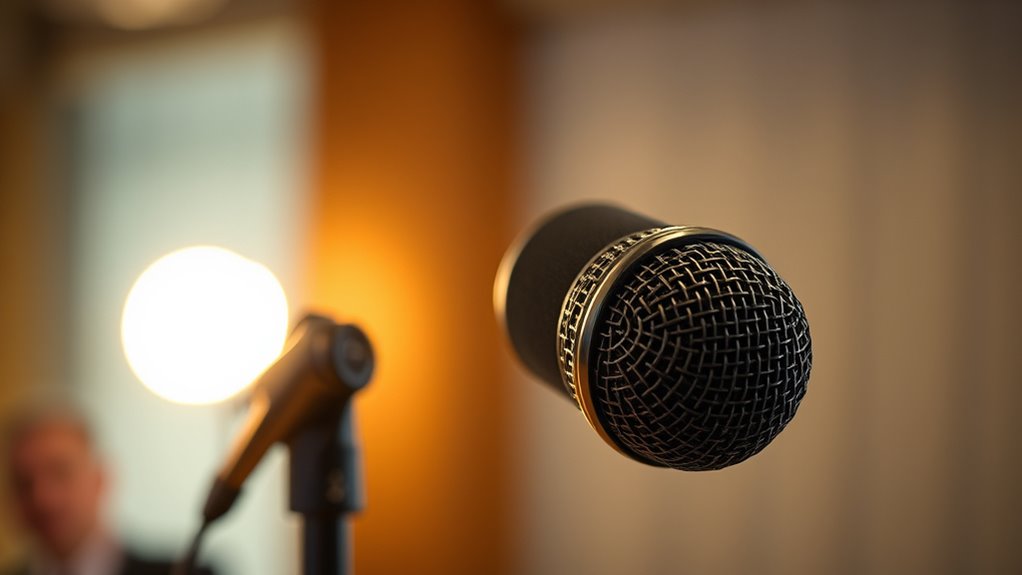Directional microphones enhance speech clarity by focusing on sounds directly in front of you, helping to filter out background noise. They pick up your voice more clearly while minimizing unwanted sounds like chatter or traffic. This targeted focus makes conversations easier to follow, especially in noisy places like restaurants or social gatherings. As a result, you won’t have to strain or ask for repetitions. Keep exploring to discover how this technology can transform your listening experience.
Key Takeaways
- Focus on sounds coming from a specific direction, primarily the speaker, to improve speech clarity.
- Minimize background noise and ambient sounds, reducing distractions during conversations.
- Automatically adapt to environmental changes, maintaining optimal focus on the desired sound source.
- Enhance signal-to-noise ratio, making speech easier to understand in noisy environments.
- Reduce listening effort and fatigue by filtering out unwanted sounds and emphasizing speech.

Have you ever struggled to hear a conversation clearly in a noisy environment? It’s frustrating when background noise seems to drown out what you’re trying to listen to, making it difficult to focus on the speaker. That’s where directional microphones come in, offering a solution to improve speech clarity amid the chaos. These microphones are designed to enhance acoustic focus, which means they can pick up sounds from specific directions—usually from the person you’re talking to—while minimizing unwanted background noise. This targeted approach helps you concentrate on the conversation at hand without having to strain or ask others to repeat themselves constantly.
Directional microphones focus on speech from specific directions, reducing background noise for clearer conversations.
The key to their effectiveness lies in how they filter sound. Unlike omnidirectional microphones that capture sound equally from all directions, directional microphones are engineered to focus on a particular area, typically in front of you. This focus is achieved through advanced technology that emphasizes the sound source you’re interested in, such as someone speaking directly to you. As a result, ambient background noise—think of chatter, traffic, or other environmental sounds—becomes less intrusive. This acoustic focus allows your brain to more easily distinguish speech from the surrounding noise, reducing listening fatigue and making conversations more natural and effortless.
Using a directional microphone can dramatically improve your experience in busy places like restaurants, crowded streets, or social gatherings. Instead of turning up the volume or asking people to repeat themselves, the microphone’s design helps you naturally hear what’s important. This makes it easier to follow conversations without distraction, and it can also enhance comprehension, especially for those with hearing difficulties. The ability to filter out background noise isn’t just about comfort; it’s about gaining better control over your listening environment. You’ll find yourself more engaged in conversations and less exhausted by the effort it takes to focus.
Furthermore, modern directional microphones are compact and easy to use, often integrated into hearing aids, communication devices, or recording equipment. They adapt quickly to changing environments, automatically adjusting their acoustic focus to optimize speech clarity. This flexibility means you don’t have to manually reposition the device constantly; it intelligently targets the sound source you want to hear, regardless of how your surroundings shift. With these innovations, you regain confidence in noisy settings and experience clearer, more natural communication. In essence, directional microphones transform chaotic soundscapes into manageable, focused audio, making your everyday interactions more effortless and enjoyable. Additionally, advancements in comfort and support solutions ensure that these devices are not only effective but also comfortable for extended wear.
Frequently Asked Questions
Can Directional Microphones Be Used in Outdoor Environments Effectively?
You might wonder if directional microphones work well outdoors. They can be effective, but wind noise and environmental factors pose challenges. To improve performance, use windshields or wind jammers to reduce wind noise. Position the microphone carefully, aiming it directly at the sound source. While they help focus on speech, you’ll need to account for environmental factors like background noise and weather conditions for the best clarity outdoors.
Do Directional Microphones Require Special Maintenance or Adjustments?
You don’t need to do much maintenance on directional microphones, but regular routines like cleaning the grille and checking cables help keep them in top shape. Adjustment procedures are straightforward; you may need to fine-tune the focus or directionality depending on your environment. Follow the manufacturer’s guidelines for calibration, and avoid exposure to extreme temperatures or moisture to guarantee consistent performance. Proper care extends your microphone’s lifespan and maintains ideal clarity.
How Do Directional Microphones Compare to Omnidirectional Types in Noisy Settings?
In noisy settings, you might wonder which microphone truly stands out. Directional microphones excel by focusing on your voice, offering superior noise cancellation and a tailored frequency response, making speech clearer amidst chaos. Unlike omnidirectional types, they cut through background sounds, ensuring your message is heard loud and clear. This precision transforms communication, giving you confidence to speak even in the most challenging environments.
Are There Different Types of Directional Microphones for Specific Applications?
You’ll find various types of directional microphones designed for specific applications, each with unique polar patterns like cardioid, supercardioid, and hypercardioid. These patterns help you focus on desired sound sources while rejecting background noise. Additionally, their frequency responses are tailored to match particular environments, such as live performances or studio recording. Choosing the right microphone depends on your needs for clarity, rejection, and sound fidelity in different settings.
Can Directional Microphones Improve Speech Clarity for Hearing-Impaired Individuals?
Ever wondered how you can hear better in noisy places? Directional microphones markedly improve speech clarity for hearing-impaired individuals by focusing on your voice and reducing background noise. They enable effective speech enhancement and noise reduction, making conversations clearer. By capturing sounds from specific directions, these microphones help you hear important words more distinctly, enhancing your overall listening experience and confidence in social settings.
Conclusion
By choosing directional microphones, you’re tuning into a clearer world, like switching from a muffled radio to a crystal-clear broadcast. They cut through background noise like a lighthouse piercing through fog, guiding your voice directly to listeners’ ears. With these microphones, your speech becomes a spotlight in a crowded room, shining brightly and unmistakably. Embrace this technology, and watch your words take center stage, leaving distractions behind and clarity front and center.











